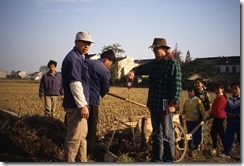 Why do we need GLOBE? Because in the Anthropocene, local change is global change.
Why do we need GLOBE? Because in the Anthropocene, local change is global change.
In the early 1990s, I set out to study ecological sustainability in China’s Tai Lake Region; famous since ancient times for high rice yields and dense populations. What I learned from the farmers of Xiejia Village changed me for good. These small-scale farmers were changing the world one field, one tree, one house at a time.
To understand the global changes caused by agriculture, urbanization and other uses of land, we must generalize globally from observations made locally. GLOBE (Global Collaboration Engine) combines local case studies with global data to investigate local change at global scales. Here I show how the global context of Xiejia Village can be mapped in real time and used to identify and connect with local knowledge from around the world (apologies for poor video quality).
 Xiejia Village is a typical rice village of the Yangtze Delta Region of China- I’ve shared the location of the village in GLOBE together with a paper I published on landscape changes from the 1930s to 1994 (Ellis et al., 2000). The study is now published online as a GLOBE Case, with a DOI, and can now be cited as:
Xiejia Village is a typical rice village of the Yangtze Delta Region of China- I’ve shared the location of the village in GLOBE together with a paper I published on landscape changes from the 1930s to 1994 (Ellis et al., 2000). The study is now published online as a GLOBE Case, with a DOI, and can now be cited as:
Ellis, E. C.,”Xiejia Village”. GLOBE Georeferenced Case Study. Published February 19, 2014. doi:10.7933/K1154F00
As you can see, the village is located in the Yangtze Delta Plain, near Tai Lake, not far from Shanghai.
To assess the global context of Xiejia Village, I use GLOBE to conduct a Similarity Analysis. To do this, I first limit the extent of the relevant global area by excluding areas of wildlands.
 Next, I assess similarity to other rice growing areas, by comparing percent cover by rice crops in the vicinity of Xiejia with a global map of % rice cover. GLOBE similarity analysis then identified the most similar site as this one, in Vietnam. This is a hilly and fairly remote site, so I am not satisfied that I have assessed a global context similar to that of Xieija.
Next, I assess similarity to other rice growing areas, by comparing percent cover by rice crops in the vicinity of Xiejia with a global map of % rice cover. GLOBE similarity analysis then identified the most similar site as this one, in Vietnam. This is a hilly and fairly remote site, so I am not satisfied that I have assessed a global context similar to that of Xieija.
So, I add in another global variable, Market Influence Index, to see if I can identify global contexts that are also close to markets, like Xiejia, which is near Shanghai. Now, GLOBE identifies a rice floodplain site near Tokyo- definitely has a globally similar context as Xiejia. Very interesting: I have a look at the author and published article- the source of this case study. I also send an email to him.
Now I’m satisfied that I have identified a global context for the landscapes of Xiejia Village, so it is time to share my global similarity analysis as a published report- with a DOI- and tweet it out on twitter!
is time to share my global similarity analysis as a published report- with a DOI- and tweet it out on twitter!
What will you learn when you explore the global context of your case studies?




